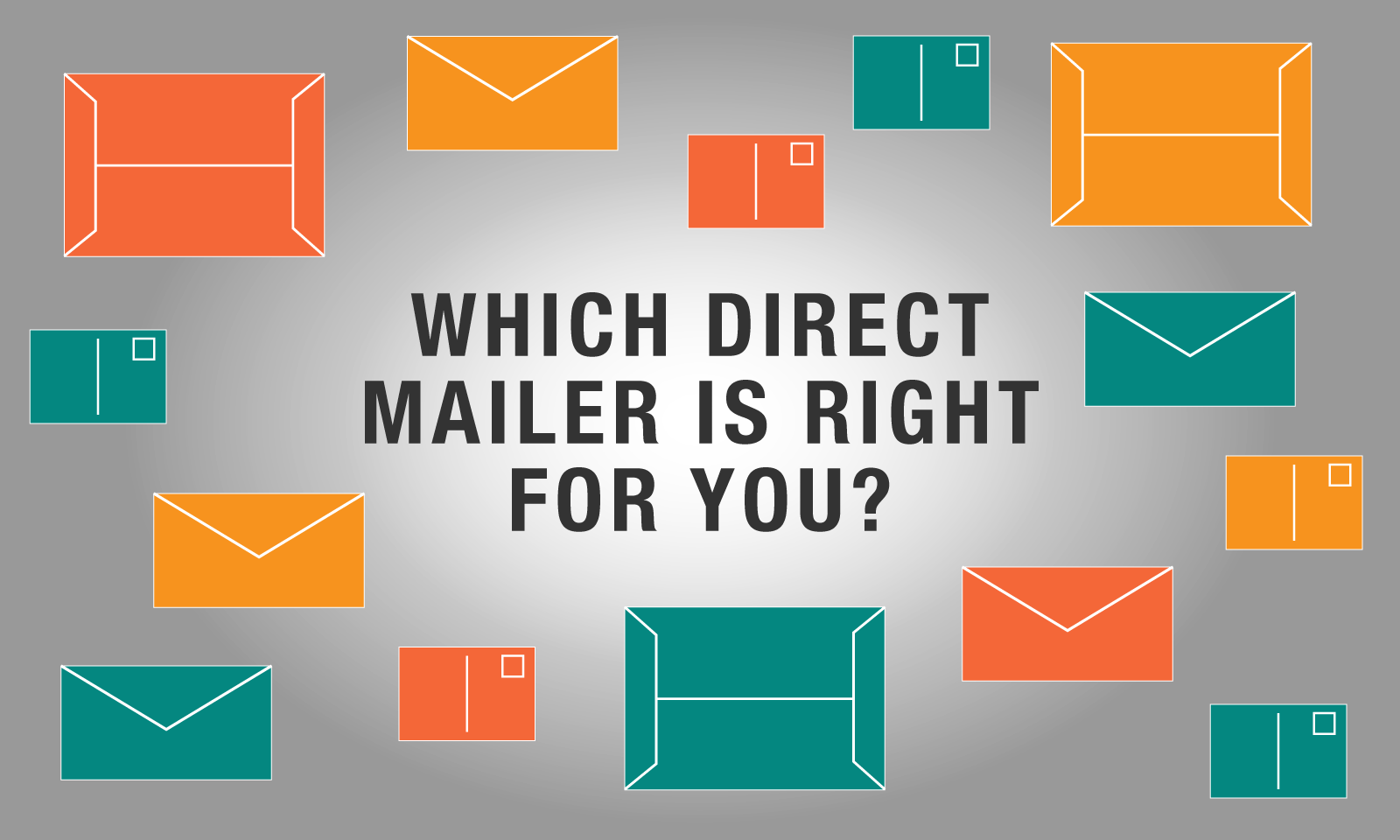What type of direct mailer should you use for your next campaign? That depends on a number of factors, such as design and messaging needs, postage rates, and USPS limitations.
In this post, we’ll review the pros and cons of three common direct mail types to help you make an informed decision in your future purchases.
The direct mailer options we will review include:
- Postcards
- Every Door Direct Mail (a.k.a. EDDM or Marketing Mail)
- Flats and Large Envelopes
Direct Mailer Option 1: Postcards
Common Postcard Dimensions
The following postcard dimensions are the most common when it comes to direct mailers, all of which qualify under USPS size guidelines:
- 4.25″x5.5″
- 4″x6″
- 4.25″x6″
- 5″x7″
- 6″x8″
- 5.5″x8.5″
- 4″x9″
- 6″x9″
- 6″x11″
Pros of using Postcards
Forget the extra logistics that come with envelopes, such as the cost of material and printing or the added step of stuffing or mail-matching. You can skip that all together with postcards and save on your mail expenditures in that regard.
Larger postcards, like 6″x9″ or 6″x11″, attract more attention to your mail campaign, too. (Smaller postcards qualify for better rates, though.)
Related Post: 2021 USPS Prices
An overview of the United States Postal Service’s mailing prices for 2021.
Cons of Using Postcards
As we alluded to above, if your postcard is larger than 4.25″x6″, it now qualifies as letter size. This unfortunately translates to increased postage pricing. (Unless you are sending as Marketing Mail, there is no discount for the smaller size.)
Also, postcards up to 4.25″x6″ must be thicker than 0.007″ and 0.009 thickness for sizes greater than that. (Don’t have your paper micrometer on hand? That’s roughly equivalent to an index card or 100# gloss cover paper.) This means slightly increased costs in materials; generally the thicker the paper, the more it costs.
One element of postcard mailing that is out of a printer’s hands is how the USPS processes the postcards for mailing. The friction in their machinery as the postcard gets ran through the automated sorting system can often cause ink smudges smack-dab in the center of the postcard’s front.
The best workaround we can suggest if you prefer postcard over envelope mailing is to print with more white space to reduce–or potentially even eliminate–ink smudges. Certain paper coatings, like uncoated, dull, or satin finishes can also withstand the machine’s friction a bit better because the ink is able to absorb more into the paper. This isn’t a fool-proof method, though.
Bottom Line for this Option
If you want to cut mailing costs and use a cost-effective postcard option, go with a small postcard, like 4″x6″ or 4.25″x5.5″ to obtain First Class Postcard pricing and speedier delivery time.
But, if you want to get more attention and your mailing goals and budget align to accommodate for letter-size pricing and potentially more lagging delivery time (if you’re sending as Marketing Mail), then by all means, go big, baby!
Direct Mailer Option 2: Every Door Direct Mail (EDDM)
EDDM, or Every Day Direct Mail offers more affordable postcard postage rates and convenience for qualifying businesses. The USPS states that this option is suitable for small businesses targeting a specific mailing area. This type of direct mail is also known as Marketing Mail.
Common Every Door Direct Mail (EDDM) Dimensions
The following EDDM postcard dimensions are approved by the USPS.
- 11″x17″
- 8.5″x11″
- 6.25″x9″
- 4.25″x11″
Related Post: Mail Classifications Made Simple
This chart outlines common USPS mail classifications and specifications to simplify mailing.
Pros of using EDDM
At 18¢ per EDDM piece, this is a fantastic price.
Check out this quick video put together by USPS for an overview of EDDM.
Cons of using EDDM
The USPS imposes a lot of restrictions with this mail type, including:
- Having a USPS.com account *This isn’t required if Delzer prepares the mailing
- Having a batch size of 200-5,000 pieces per day, per ZIP code *Better batch sizes through Delzer
- Dropping the mail pieces at the USPS Postal Office
- Lack of customization options, including dimensions
- Tied to specific mailing route and must send to every address on the route
- Mailings are sent as Marketing Mail, so delivery times are slower.
Furthermore, the following special preparation of mailings are required:
- Bundling mailing in stacks of 50-100 pieces (for example, if a route has 1,000 addresses, create 10 bundles of 100 pieces each for the route).
- Bundles may not be higher than 6″
- An EDDM-facing slip must be filled out and attached to the top of every bundle with the number of pieces identified
Bottom Line For this Option
If you need flexibility with your mailing itself or the timeline associated with it, this option is rather limiting. But, if you’re able to follow USPS guidelines for EDDM, you can save money while using larger postcard sizes – something that isn’t included in standard postcard mailing.
By working with a printer like Delzer to prepare your mailings, you are able to work around the retailer restrictions of EDDM through the post office. You don’t have to create a USPS.com account and have much more forgiving batch size limitations – not to mention, the tedious work behind the mail preparation is no longer your detail to figure out.
Direct Mailer Option 3: Flats and Large Envelopes
First of all, what qualifies as a flat? Flats are a collective term for items like newsletters, large envelopes, and magazines that have a 1″ minimum of flexibility in their structure.
Note: Items like boxes and tight envelopes filled with books do not qualify as a flat. These would be considered as packages or parcels, which have their own shipping protocol determined by size and weight.
Related Post: Kitting, A Flavorsome Slice of Marketing Strategy.
Kitting is a robust alternative to direct mail marketing, allowing you to showcase your products and engage with your audiences remotely, which is important now more than ever.
Common Flats and Large Envelope Dimensions
The following dimensions are approved by the USPS for flats and large envelopes.
- Min./Max. Height: 6-1/8″ to 12″
- Min./Max. Length: 11-1/2″ to 15″
- Max. Thickness: 3/4″
If a mailing piece meets any of the minimum criteria, it is considered a flat. Additionally, a piece doesn’t need to meet all three minimums to qualify. For example, a 6-1/4″x10″ or 6″x12″ postcard is still considered a flat.
Pros of using Flats and Large Envelopes
Postcards can be severely limiting when it comes to available print real estate and are best used for marketing strategies like brand awareness or a specific Call to Action. Flats and large envelopes, on the other hand, are ideal if you need to get out more content, like catalogs or service overviews.
Plus, you don’t have to worry about the post office compromising your art in the machine’s sorting process since it’s safely enclosed in its packaging.
Cons of using Flats and Large Envelopes
Unfortunately, with greater size comes greater pricing–but you probably gathered that by now.
Large envelopes or flats equivalent or less than 1 oz. cost $1.00 per piece first-class compared to 36¢ for standard-sized domestic postcards.
Plus, don’t forget that you’ll need to budget more for production costs with your printer.
Worth Mentioning: The use of stay-flats or polybag mailers automatically qualifies a mail piece as a parcel, even if they meet the other criteria. Another automatic qualification for a parcel is if the piece is too rigid.
Bottom Line For this Option
If getting a large amount of content out to recipients in crisp shape is more important to you than print production and mailing costs, this option is for you. But, if you’re shy on the budget and don’t need many bells or whistles in your aesthetics or messaging, then you might be better suited for a postcard or EDDM direct mailer.
Which Direct Mail Type is Right for You?
All three direct mailers have their pros and cons, as outlined above. By preparing your art’s dimensions for design, costs, and deliverability, your direct mail campaign will be that much more successful.
If your focus is on cost-effectivity, pay attention to postcard dimensions. Don’t exceed 4.25″x6″ to stay within First-Class Mail category and get the best postcard rate. Consider meeting EDDM requirements to get an even better rate.
If your focus is on mailpiece integrity, enveloped direct mailers will keep your piece from being damaged in USPS machines.
If your focus is on grabbing attention, large postcards, flats, and large envelopes will definitely increase your chances of being noticed in that pile of mail.
If you’re still unsure of what your best option is, our Delzer Reps are happy to discuss your unique situation together to help you make an informed decision that meets your direct mail marketing goals.
Get started on your Next Direct Mail Strategy with Delzer:
Tell us what you’re thinking for your direct mail campaign.


